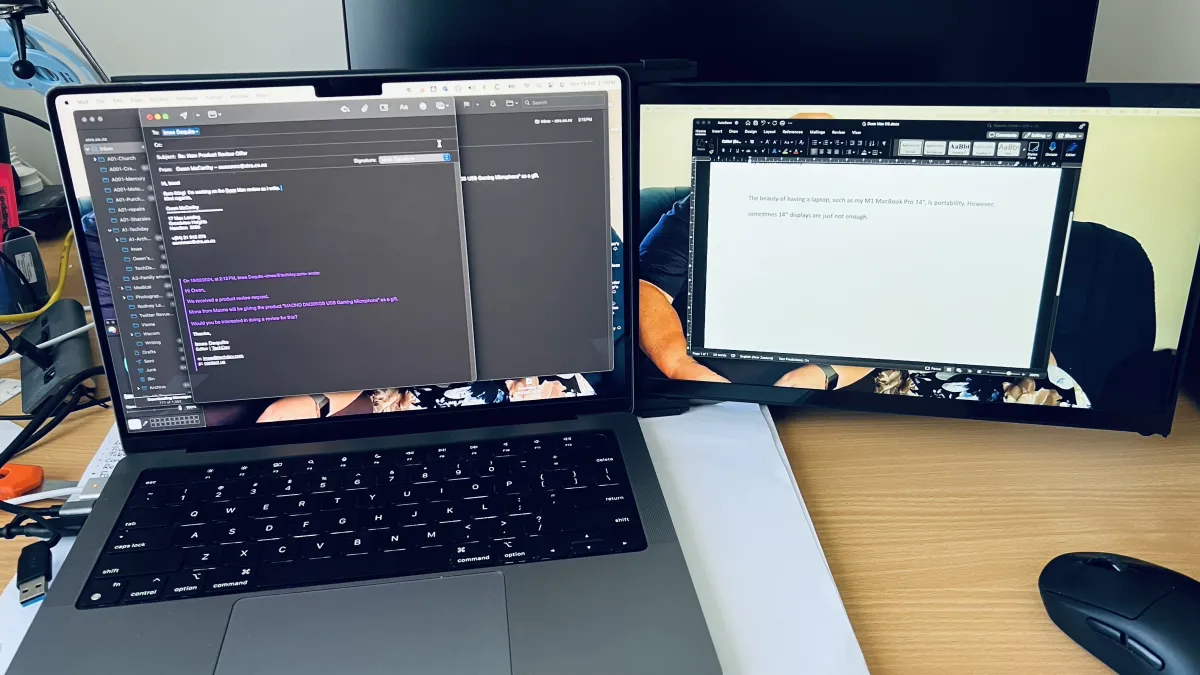
Hands-on review: Mobile Pixels Duex Max DS: Time to double up!
The beauty of having a laptop, such as my M1 MacBook Pro 14", is portability. However, sometimes 14" displays are just not enough. Equally impossible is the idea of carting around my 27-inch external monitor. Portability isn't really its thing.
Mobile Pixels Duex Max DS is a 14.1" portable monitor that clips to your laptop magnetically. For me, it means a doubling of my workspace, with everything in my line of sight without having to raise my head.

Setting up consisted of using their template for attaching magnets to the rear of my laptop screen, plugging in the USB C cable, tweaking my monitor settings, and deciding whether to place the Duex Max on the left or the right. So far, I've tried both positions without any major issues. The magnets are nicely set up to allow you to offset to either the left or the right. I can personally attest to their stickability. This monitor isn't going anywhere once you have it set up.
Technical Specifications: Duex Max DS
Material: ABS and aluminium alloy
Size: 14.1 in 1080p FHD display
Resolution: 1920 x 1080 pixels
Brightness: 300 nit (adjustable)
Refresh Rate: 60 Hz
Weight 1.8 lbs (0.8kg)
Plug and play via 2 USB-C port
Hybrid Signals: YES
Eye-Care Mode: YES
Auto-Rotation: YES
Compatible with: MacOS, Windows, Nintendo Switch, Samsung Dex
My user experience lived up to what Mobile Pixels had to say about the Duex Max DS. While I did notice the extra 0.8kg of weight, my MacBook was still comfortably tucked under my arm.
I was interested to see whether I'd notice any difference from my laptop's monitor, but the 300 nits brightness and 60 Hz refresh rate proved to be more adequate for watching my favourite YouTube videos (I'm in my Golden Retriever puppy phase), and the resolution delivered crisp and clear video. While my Mac Display is brighter, the difference was difficult for me to detect with the naked eye. Even with the sun shining, I have had no issues with visibility. The brightness is easily adjusted up and down courtesy of buttons on the rear of the monitor.
My MacBook Pro is renowned for its robust screen, which doesn't have the flexion that you find with some other laptops. It provides a stable platform for the Duex Max, reducing the amount of wobble you might expect from a side-mounted monitor. I found it very stable. Moving the Duex Max from the left to the right of my screen proved a breeze, with a quick tweak in my display arrangement settings allowing for smooth cursor movement from one monitor to the other. It automatically rotates your picture, making changing over a seamless process.
The longer I have spent on this dual-screen experience, the more I've come to appreciate it. I find myself continually adjusting the angle, sliding it in and out of its housing, and revelling in the double expanse of the screen now available to me. I have even detached it from the laptop and had it sitting comfortably on my desk while carrying on working with the laptop in my lap. Being able to extend my workspace has made many of my work tasks much simpler. I can edit photos on the fly while writing about what I'm doing. As I wrote, I started to think of you, dear readers.
I'm sure that, like me, you have had the dreaded huddle around one laptop screen when making a presentation on the fly. With the Duex Max DS, simply mirror your screen and rotate in the direction of your audience. Your extended workspace is suddenly transformed into a highly portable presentation device without the need to holler for an onsite technician to set you up.
Price-wise, the Duex Max DS appears to have a price point around the NZ$ 500 -$550 mark. For those of us who frequently work in more than one location, the Duex Max DS lets you maintain your freedom of movement and still have the luxury of a multiple monitor setup.


